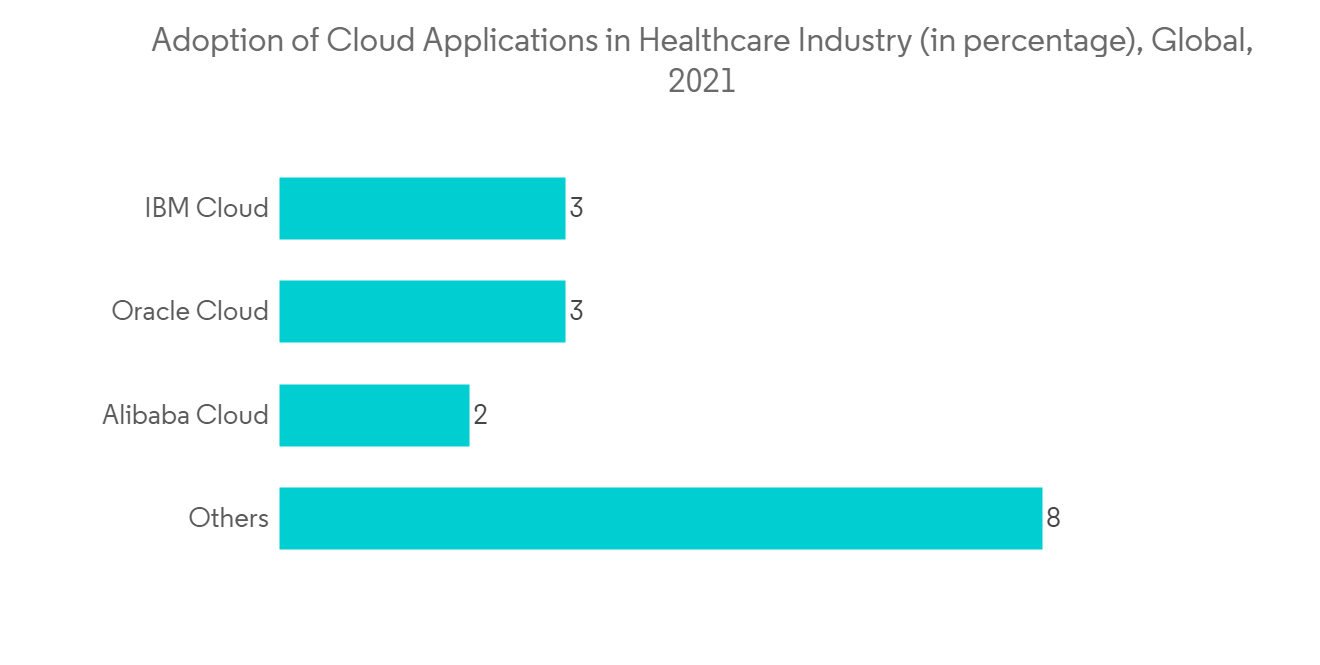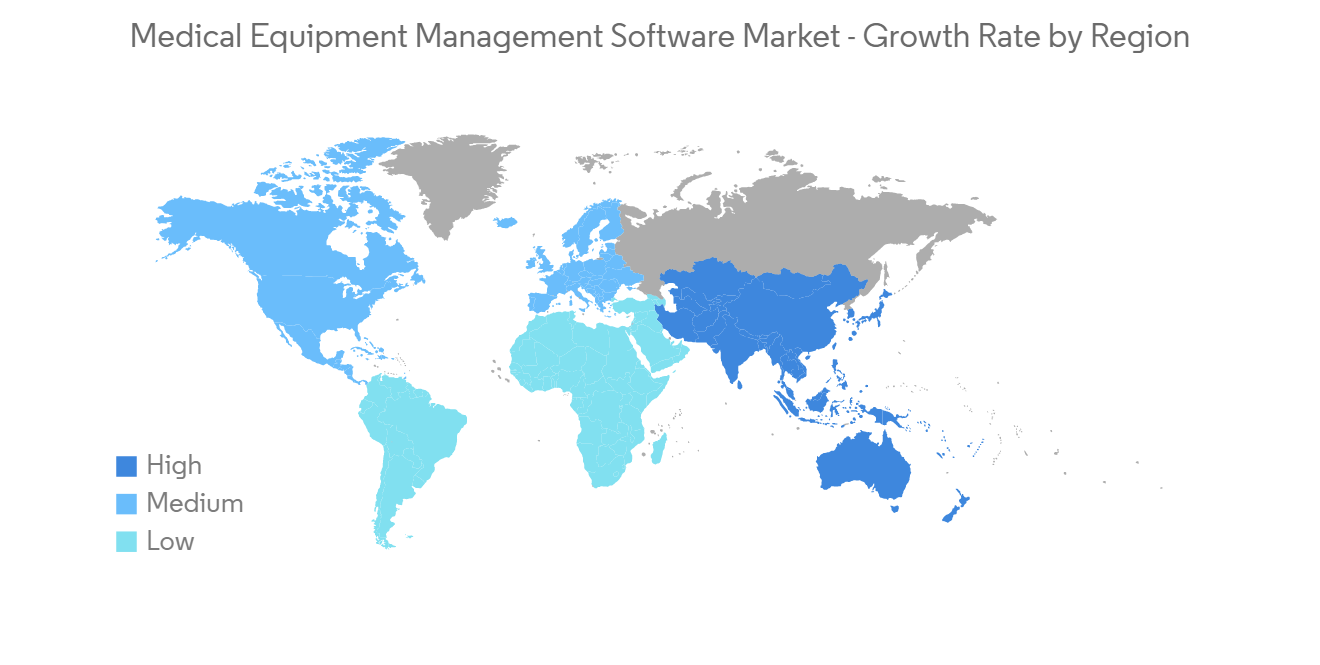PUBLISHER: Mordor Intelligence | PRODUCT CODE: 1244375

PUBLISHER: Mordor Intelligence | PRODUCT CODE: 1244375
Medical Equipment Management Software Market - Growth, Trends, and Forecasts (2023 - 2028)
The medical equipment management software market is expected to register a CAGR of 9.9% during the forecast period.
The COVID-19 pandemic initially impacted the medical equipment management software market in 2020, as there was a decrease in patient visits in hospitals and clinics, which subsequently decreased the demand for medical equipment management software. For instance, according to an article published by BMJ Journals in February 2021, a systemic study was performed to determine the extent and nature of changes in the utilization of healthcare software and services during the COVID-19 pandemic. It was found that healthcare software and services utilization decreased by about a third during the pandemic as many hospitals and clinics which were not providing essential COVID-19 care remained closed. Thus, the COVID-19 pandemic adversely affected the market's growth in its preliminary phase. However, the market is expected to grow in the post-pandemic scenario.
Further, the increasing number of hospitals and clinics, technological advancements in the development of web-based and cloud-based software, and rising government initiatives to develop advanced software are among the major factors driving the growth of the medical equipment management software market.
As the number of hospitals and clinics increases worldwide, the use of medical equipment management software is also expected to increase. For instance, according to the data by European Commission (EU) reported in May 2021, Germany has a large hospital inpatient sector, with 7.9 hospital beds per 1000 population which is the highest in the EU and 50% more than the Europe average (5.3 beds). This indicates that there will be more utilization of medical equipment management software to manage the hospital inventory. Furthermore, according to the data by the Australian Institute of Health and Welfare (AIHW) published in July 2022, in 2020-21, there were 697 public hospitals in Australia, which increased considerably in the last five years. Therefore, as the number of hospitals and clinics increases, the utilization of medical equipment management software is also expected to increase, thereby driving the growth of the medical equipment management software market during the forecast period.
Furthermore, new product launches and strategic activities by major players in the market are positively affecting the growth of the medical equipment management software market. For instance, in June 2022, Syft, a subsidiary of GHX and a leading national provider of healthcare inventory control and end-to-end supply chain management software and services, released Syft Synergy 4.5. with enhancements to the supply chain management software platform, including a redesigned mobile app interface that simplifies processes for receiving and distributing supplies. Additionally, in September 2020, Lumiere32 launched a new AI-driven inventory management software platform for clinics nationwide. Thus, due to product launches and partnerships, the medical equipment management software market is expected to have significant growth during the forecast period.
However, concerns over data privacy and a lack of skilled professionals are likely to impede market growth.
Medical Equipment Management Software Market Trends
Cloud-Based Segment is Expected to Witness Growth During the Forecast Period
Cloud-based software is application software that is hosted in the cloud. It can be accessed via a web browser or a dedicated desktop client that integrates with the desktop or mobile operating system. Moreover, according to an article published by The Patient Safety Company in October 2021, cloud-based medical equipment management software in healthcare provides organizations with a unique balance of security, data-sharing capabilities, and scalability. It is more cost-effective than on-site data centers and substantially more secure than hosting data on personal computers. Hence, owing to the advantages of cloud-based medical equipment management software, the adoption of these products is likely to increase among the target population, ultimately driving the growth of the medical equipment management software market.
In addition, cloud-based software can make it easier for organizations to improve their inventory management effectively and efficiently, as all the data will be recorded automatically with cloud stock which can be accessed and used to calculate inventory easily. Thus, technologically advanced cloud-based medical equipment management software is creating opportunities for future growth of the segment.
Furthermore, product launches by major players in the market are positively affecting the growth of the segment. For instance, in March 2022, Microsoft launched its cloud-based Azure Health Data Services platform for healthcare organizations. Additionally, in June 2021, iCoreConnect Inc., a cloud-based, Software-as-a-Service (SaaS) platform for healthcare business workflow, announced the expansion of its SaaS enterprise solutions with the launch of iCoreCloud for healthcare organizations. Moreover, the increasing adoption of cloud-based services in the healthcare industry is also boosting the growth of the medical equipment management software market segment.
Therefore, the cloud-based segment is expected to witness significant growth during the forecast period.

North America is Dominating the Medical Equipment Management Software Market
North America dominated the market in 2021. It is expected to maintain its dominance during the forecast period, owing to the well-established infrastructure, high adoption of medical equipment management software products, and presence of the major market players in the region. In addition, the rise in the number of hospitals and clinics established in the United States is generating the demand for management software. This is also one of the key factors contributing to the growth of the market in North America.
For instance, according to the data from American Hospital Association (AHA), in January 2022, there were 6,093 hospitals in the United States, an increase from 6,090 in January 2021. With the increase in the number of hospitals and clinics, equipment in hospitals is also poised to increase, leading to the adoption of more medical equipment management software. Hence, it is anticipated to drive the growth of the market in the country.
Therefore, owing to the factors mentioned above, the growth of the medical equipment management software market is anticipated in North America.

Medical Equipment Management Software Industry Overview
The medical equipment management software market is fragmented due to the presence of several companies operating globally and regionally. The competitive landscape includes an analysis of a few international and local companies which hold market shares and are well known. Some market players include Fortunesoft, Mymediset, CrelioHealth Inc., eLabNext, EZOfficeInventory, Hybrent Inc., a Procurement Partners Company, eTurns Inc., Service Works Global, Innomaint, and Crothall Healthcare among others.
Additional Benefits:
- The market estimate (ME) sheet in Excel format
- 3 months of analyst support
TABLE OF CONTENTS
1 INTRODUCTION
- 1.1 Study Assumptions and Market Definition
- 1.2 Scope of the Study
2 RESEARCH METHODOLOGY
3 EXECUTIVE SUMMARY
4 MARKET DYNAMICS
- 4.1 Market Overview
- 4.2 Market Drivers
- 4.2.1 Increasing Number of Hospitals and Clinics
- 4.2.2 Technological Advancements in the Development of Web-Based and Cloud-Based Software
- 4.2.3 Rising Government Initiatives to Develop Advanced Software
- 4.3 Market Restraints
- 4.3.1 Concerns Over Data Privacy
- 4.3.2 Lack of Skilled Professionals
- 4.4 Porter's Five Force Analysis
- 4.4.1 Threat of New Entrants
- 4.4.2 Bargaining Power of Buyers/Consumers
- 4.4.3 Bargaining Power of Suppliers
- 4.4.4 Threat of Substitute Products
- 4.4.5 Intensity of Competitive Rivalry
5 MARKET SEGMENTATION (Market Size by Value - USD million)
- 5.1 By Deployment Mode
- 5.1.1 Cloud-Based
- 5.1.2 Web-Based
- 5.2 By End User
- 5.2.1 Hospitals
- 5.2.2 Clinics
- 5.2.3 Ambulatory Surgical Centers
- 5.2.4 Other End Users
- 5.3 Geography
- 5.3.1 North America
- 5.3.1.1 United States
- 5.3.1.2 Canada
- 5.3.1.3 Mexico
- 5.3.2 Europe
- 5.3.2.1 Germany
- 5.3.2.2 United Kingdom
- 5.3.2.3 France
- 5.3.2.4 Italy
- 5.3.2.5 Spain
- 5.3.2.6 Rest of Europe
- 5.3.3 Asia-Pacific
- 5.3.3.1 China
- 5.3.3.2 Japan
- 5.3.3.3 India
- 5.3.3.4 Australia
- 5.3.3.5 South Korea
- 5.3.3.6 Rest of Asia-Pacific
- 5.3.4 Rest of the World
- 5.3.1 North America
6 COMPETITIVE LANDSCAPE
- 6.1 Company Profiles
- 6.1.1 Fortunesoft
- 6.1.2 Mymediset
- 6.1.3 CrelioHealth Inc.
- 6.1.4 eLabNext
- 6.1.5 EZOfficeInventory
- 6.1.6 Hybrent Inc. a Procurement Partners Company
- 6.1.7 eTurns Inc.
- 6.1.8 Service Works Global
- 6.1.9 Innomaint
- 6.1.10 Crothall Healthcare
7 MARKET OPPORTUNITIES AND FUTURE TRENDS




